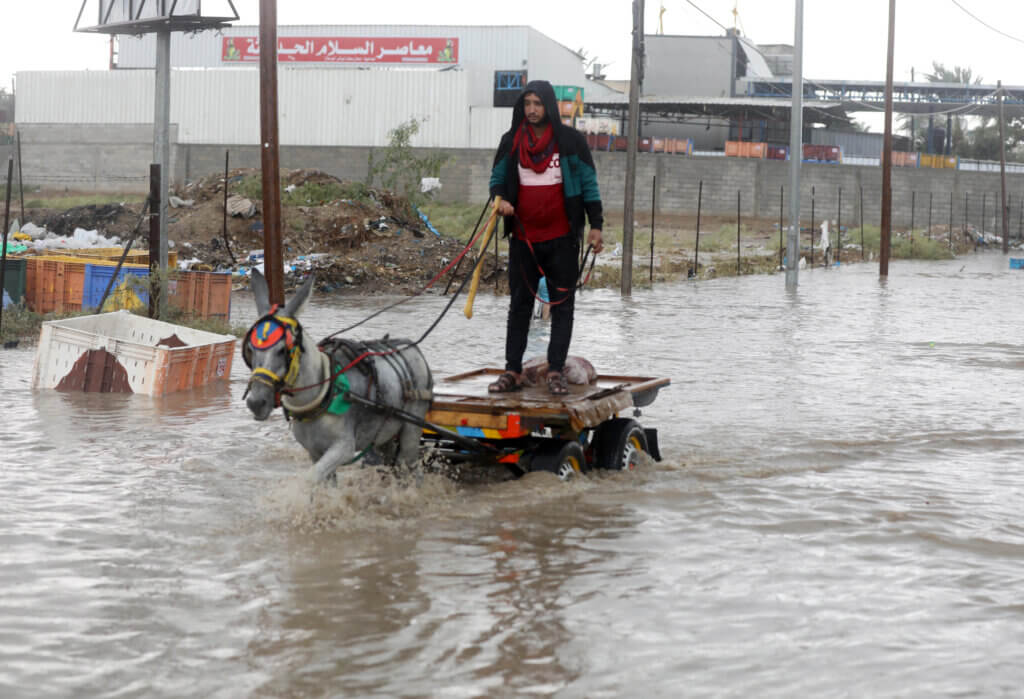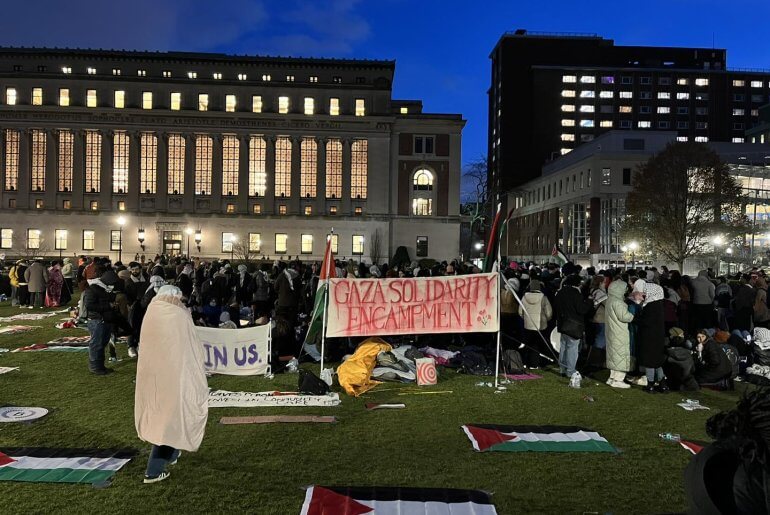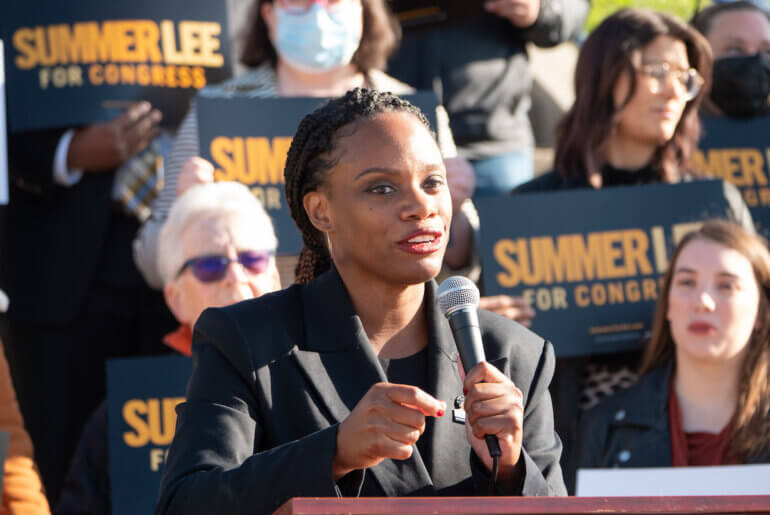
It is winter in Gaza. It used to be a lovely season. People would envy Gaza’s temperate climate, when rain was seen as a source of livelihood rather than as a harbinger of an incoming disaster. Things are different now. Today, when rain is on the forecast, families start to worry about how their children will get to school during the inevitable floods that will follow. The image of children wading through waist-high flooded streets has become a common sight this winter.
The rain season wasn’t always like this. 20 years ago floods were rarely observed in Gaza, even though rain rates used to be much heavier than they are now. The difference is that Gaza used to have an infrastructure, which has since been nearly wiped out by Israel’s wars and never-ending blockade. Today, even if it rains for only a few hours, several streets are flooded and water enters into peoples’ homes.
From one year to another floods have only increased in severity despite the long list of accomplishments declared by the Gaza municipality. But of course the municipality doesn’t have the luxury of actually developing Gaza’s infrastructure — it’s too busy trying to catch up with repairing the devastation wreaked by Israel’s wars. The current situation should sound the alarm that there is a growing infrastructure crisis in Gaza which is exacerbated both by climate change and the Israeli siege. Ill-prepared and weak points in Gaza’s infrastructure will be the first to break. People’s lives will be exposed to untold danger, experts say.

In November, the first wave of winter rain was visited upon the coastal strip. It started in the morning and stopped in the afternoon. In that short period, everything changed on the ground. Schools were packed with stranded students who were unable to make it home. Cars could not move, and people stood helpless until the municipality handled the situation. The floods weren’t only made up of rain, either. Sewage pipes exploded as a result of the pressure created by the rain on the water-wells. People hitched rides in the mouths of the municipality’s bulldozers, which ended up ferrying people from one side of streets to the other.
These conditions only hold a harsh future for people in Gaza.
“Most places affected by climate change are those with the weakest and least prepared infrastructures, and their people will pay the price for climate change,” Dr. Ahmad Hilles, head of the National Institute for Environment and Development, told Mondoweiss.

Increasing population density strains infrastructure
Attempts to cope with the increase in Gaza’s population have been met with Israeli obstacles at every turn. The Palestinian Authority’s work over several years on one project meant to supply the Strip with sources of clean energy in Al-Bureij refugee camp, for instance, was obliterated when Israel bombed the project during Operation Guardian of the Walls in 2021, before its completion.
“Day by day, the Palestinian population increases in Gaza faster than any other place in the world. Every year, 70-75,000 people are born in Gaza,” Hilles told Mondoweiss. “They share the same resources, the same environment, the same infrastructure. All of this is happening in a besieged strip of land. One of the direct results of the siege has been that the number of people has exceeded the environment’s ability to accommodate them.”
The municipality warns that Gaza, with the highest population density in the world, will not be able to handle the current situation for much longer. “It’s an old city with an old and worn-out infrastructure that is targeted directly in every Israeli offensive,” municipal representative Husni Muhanna told Mondoweiss. “The system needs comprehensive preparation, and this is beyond the municipality’s ability.”
“This winter will reveal more crises than the previous season, and the next will be even harder,” he added. “The new population should be accommodated with more facilities and a development in infrastructure. Instead, the current situation forces us to put all our efforts into repairing Israeli destruction. When it comes to repair and development, Israel prevents the entry of materials, equipment, and modern machines. All the municipality’s tools are outdated,” the representative said.

The cost of the blockade amid a natural crisis
The blockade is meant to impede the ability of Gaza to move beyond its own destruction. Controlling everything coming in and out of Gaza over the past 15 years, Israel has allowed the bare minimum of machinery into the strip. Even getting a nail into Gaza requires reams of paperwork and approvals that make sure it doesn’t fall under “dual use.” Hundreds of materials are banned from entering Gaza under this pretext, including cement, building materials, machines, steel tubes, pipes, reinforced plastic, and other materials. Anything related to energy and power is naturally also on this list.
As for the environment, Hilles warns that the worsening of climate change will lead to suffering “in all other aspects,” he tells Mondoweiss.
For instance, the Gaza municipality does not have the means to reuse the rain water due to the collapsing of the infrastructure relating to rain-collection and water-wells. Because climate change is only exacerbating the situation, the strip now faces a dangerous situation where it will be unable to handle the inevitable climate disaster relating to water access.
“Gaza faces a water shortage of over 150 million cubic meters per year,” Hilles said. “Climate change has impacted the level of rain, which is the only source for water in Gaza. We now receive 60-70 million cubic meters per year, but the strip needs 250.”
“This also badly affects the underground water reservoir,” he continued. “It gets 20-25 meters lower ever year, and that leads to seawater getting mixed into it.”
Hilles confirmed that “underground water fit for human consumption must include a TDS reading of less than 1000-1500 milligrams per liter, but in Gaza it contains a TDS of over 10,000 mg/L.”
“This means underground water becomes similar to seawater,” Hilles clarified.
Fishing and agriculture has also been badly impacted by this climate disaster, launching the people of Gaza into even greater food insecurity.

Parched futures
The first wave of rain in Gaza came late in November. The rainfall was at a rate of 45 millimeters per hour. “In a place like Gaza, this rate of rainfall means floods,” Muhana explained to Mondoweiss. “Our means made it impossible for us to clear the floods in the streets immediately. It took us over an hour to deal with a few hours of rain.”
“A single pipe can turn Gaza into a lake,” Muhanna said, barely in exaggeration, emphasizing the severity of the infrastructural mess.

Hilles believes that such situations have forced people to look for alternatives in order to survive, including alternative sources of energy. The problem is that some of these alternatives put the lives of these people in danger, and many in Gaza have lost their lives using hazardous materials to power their homes during the particularly harsh winter power outages.
“People will start looking for alternatives to survive, and this will put their lives in danger,” he said.
In 2018, the United Nations predicted that by the year of 2020, Gaza will be “unliveable.” That prediction has come to pass. Every indicator upon which that UN report based its prediction has since devolved into a full-fledged humanitarian nightmare.
“Today, we have over 140 people who get cancer every month in Gaza, and this is a direct result of what we eat and drink and breathe,” Hilles said.
“The only way for us to get past these conditions is by ending the Israeli siege,” Hilles conclude, his recommendation almost seeming wishful, perhaps even impossible.
Tareq S. Hajjaj
Tareq S. Hajjaj is the Mondoweiss Gaza Correspondent, and a member of Palestinian Writers Union. Follow him on Twitter at @Tareqshajjaj.




1: Stop picking fights with Israel.
2: Build sewers instead of tunnels for Hamas.